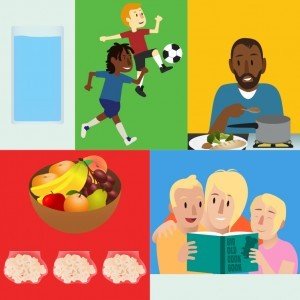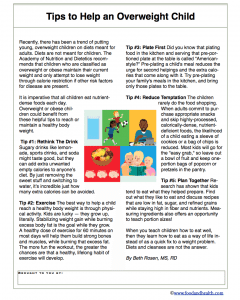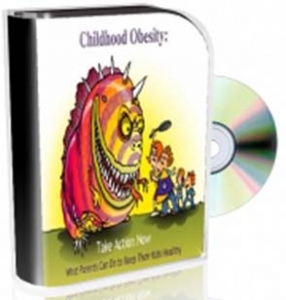Diets for Kids?
Good news! Today I'm cracking the vault to bring you a brand-new article by Beth Rosen, MS, RD. Beth created this incredible handout for the exclusive Communicating Food for Health newsletter, but it got such good reviews that I want to share it with you today. So without further ado, let's take a look at ways to help overweight children... Recently, there has been a trend of putting young, overweight children on diets meant for adults. Diets are not meant for children. The Academy of Nutrition and Dietetics recommends that children who are classified as overweight or obese maintain their current weight and only attempt to lose weight through calorie restriction if other risk factors for disease are present.It is imperative that all children eat nutrient-dense foods each day. Overweight or obese children could benefit from these helpful tips to reach or maintain a healthy body weight.Tip #1: Rethink The Drink Sugary drinks like lemonade, sports drinks, and soda might taste good, but they can add extra unwanted empty calories to anyone’s diet. By just removing the sweet stuff and switching to water, it’s incredible just how many extra calories can be avoided.Tip #2: Exercise The best way to help a child reach a healthy body weight is through physical activity. Kids are lucky — they grow up, literally. Stabilizing weight gain while burning excess body fat is the goal while they grow. A healthy dose of exercise for 60 minutes on most days will help them build strong bones and muscles, while burning that excess fat. The more fun the workout, the greater the chances are that a healthy, lifelong habit of exercise will develop.Tip #3: Plate First Did you know that plating food in the kitchen and serving that pre-portioned plate at the table is called “American-style?” Pre-plating a child's meal reduces the urge for second helpings and the extra calories that come along with it. Try pre-plating your family's meals in the kitchen, and bring only those plates to the table.Tip #4: Reduce Temptation The children rarely do the food shopping. When adults commit to purchase appropriate snacks and skip highly-processed, calorically-dense, nutrient-deficient foods, the likelihood of a child eating a sleeve of cookies or a bag of chips is reduced. Most kids will go for the "easy grab," so leave out a bowl of fruit and keep one-portion bags of popcorn or pretzels in the pantry.Tip #5: Plan Together Research has shown that kids tend to eat what they helped prepare. Find out what they like to eat and discuss recipes that are low in fat, sugar, and refined grains while staying high in fiber and nutrients. Measuring ingredients also offers an opportunity to teach portion sizes!When you teach children how to eat well, then they learn how to eat as a way of life instead of as a quick fix to a weight problem. Diets and cleanses are not the answer.By Beth Rosen, MS, RDThis article has been reproduced in its entirety from the January 2015 edition of Communicating Food for Health. If you would like access to more of these amazing handouts, research updates, and fresh new recipes, sign up for a membership today!
Recently, there has been a trend of putting young, overweight children on diets meant for adults. Diets are not meant for children. The Academy of Nutrition and Dietetics recommends that children who are classified as overweight or obese maintain their current weight and only attempt to lose weight through calorie restriction if other risk factors for disease are present.It is imperative that all children eat nutrient-dense foods each day. Overweight or obese children could benefit from these helpful tips to reach or maintain a healthy body weight.Tip #1: Rethink The Drink Sugary drinks like lemonade, sports drinks, and soda might taste good, but they can add extra unwanted empty calories to anyone’s diet. By just removing the sweet stuff and switching to water, it’s incredible just how many extra calories can be avoided.Tip #2: Exercise The best way to help a child reach a healthy body weight is through physical activity. Kids are lucky — they grow up, literally. Stabilizing weight gain while burning excess body fat is the goal while they grow. A healthy dose of exercise for 60 minutes on most days will help them build strong bones and muscles, while burning that excess fat. The more fun the workout, the greater the chances are that a healthy, lifelong habit of exercise will develop.Tip #3: Plate First Did you know that plating food in the kitchen and serving that pre-portioned plate at the table is called “American-style?” Pre-plating a child's meal reduces the urge for second helpings and the extra calories that come along with it. Try pre-plating your family's meals in the kitchen, and bring only those plates to the table.Tip #4: Reduce Temptation The children rarely do the food shopping. When adults commit to purchase appropriate snacks and skip highly-processed, calorically-dense, nutrient-deficient foods, the likelihood of a child eating a sleeve of cookies or a bag of chips is reduced. Most kids will go for the "easy grab," so leave out a bowl of fruit and keep one-portion bags of popcorn or pretzels in the pantry.Tip #5: Plan Together Research has shown that kids tend to eat what they helped prepare. Find out what they like to eat and discuss recipes that are low in fat, sugar, and refined grains while staying high in fiber and nutrients. Measuring ingredients also offers an opportunity to teach portion sizes!When you teach children how to eat well, then they learn how to eat as a way of life instead of as a quick fix to a weight problem. Diets and cleanses are not the answer.By Beth Rosen, MS, RDThis article has been reproduced in its entirety from the January 2015 edition of Communicating Food for Health. If you would like access to more of these amazing handouts, research updates, and fresh new recipes, sign up for a membership today! Oh and of course I'd like to share a PDF of the handout too. Here you go!
Oh and of course I'd like to share a PDF of the handout too. Here you go! And here are even more nutrition education resources for kids!
And here are even more nutrition education resources for kids!




